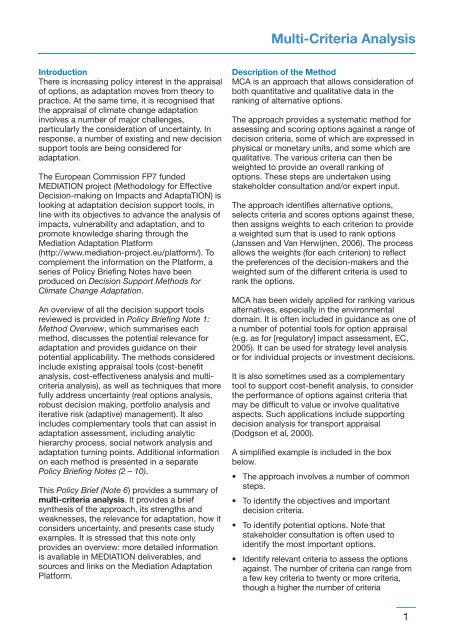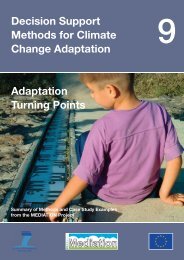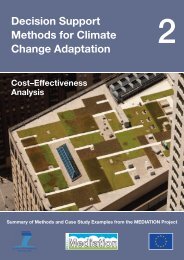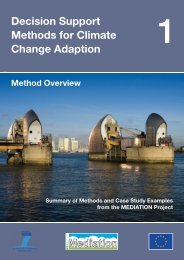Download all Technical Policy Briefing Notes in a single ... - Mediation
Download all Technical Policy Briefing Notes in a single ... - Mediation
Download all Technical Policy Briefing Notes in a single ... - Mediation
- No tags were found...
Create successful ePaper yourself
Turn your PDF publications into a flip-book with our unique Google optimized e-Paper software.
Multi-Criteria AnalysisIntroductionThere is <strong>in</strong>creas<strong>in</strong>g policy <strong>in</strong>terest <strong>in</strong> the appraisalof options, as adaptation moves from theory topractice. At the same time, it is recognised thatthe appraisal of climate change adaptation<strong>in</strong>volves a number of major ch<strong>all</strong>enges,particularly the consideration of uncerta<strong>in</strong>ty. Inresponse, a number of exist<strong>in</strong>g and new decisionsupport tools are be<strong>in</strong>g considered foradaptation.The European Commission FP7 fundedMEDIATION project (Methodology for EffectiveDecision-mak<strong>in</strong>g on Impacts and AdaptaTION) islook<strong>in</strong>g at adaptation decision support tools, <strong>in</strong>l<strong>in</strong>e with its objectives to advance the analysis ofimpacts, vulnerability and adaptation, and topromote knowledge shar<strong>in</strong>g through the<strong>Mediation</strong> Adaptation Platform(http://www.mediation-project.eu/platform/). Tocomplement the <strong>in</strong>formation on the Platform, aseries of <strong>Policy</strong> <strong>Brief<strong>in</strong>g</strong> <strong>Notes</strong> have beenproduced on Decision Support Methods forClimate Change Adaptation.An overview of <strong>all</strong> the decision support toolsreviewed is provided <strong>in</strong> <strong>Policy</strong> <strong>Brief<strong>in</strong>g</strong> Note 1:Method Overview, which summarises eachmethod, discusses the potential relevance foradaptation and provides guidance on theirpotential applicability. The methods considered<strong>in</strong>clude exist<strong>in</strong>g appraisal tools (cost-benefitanalysis, cost-effectiveness analysis and multicriteriaanalysis), as well as techniques that morefully address uncerta<strong>in</strong>ty (real options analysis,robust decision mak<strong>in</strong>g, portfolio analysis anditerative risk (adaptive) management). It also<strong>in</strong>cludes complementary tools that can assist <strong>in</strong>adaptation assessment, <strong>in</strong>clud<strong>in</strong>g analytichierarchy process, social network analysis andadaptation turn<strong>in</strong>g po<strong>in</strong>ts. Additional <strong>in</strong>formationon each method is presented <strong>in</strong> a separate<strong>Policy</strong> <strong>Brief<strong>in</strong>g</strong> <strong>Notes</strong> (2 – 10).This <strong>Policy</strong> Brief (Note 6) provides a summary ofmulti-criteria analysis. It provides a briefsynthesis of the approach, its strengths andweaknesses, the relevance for adaptation, how itconsiders uncerta<strong>in</strong>ty, and presents case studyexamples. It is stressed that this note onlyprovides an overview: more detailed <strong>in</strong>formationis available <strong>in</strong> MEDIATION deliverables, andsources and l<strong>in</strong>ks on the <strong>Mediation</strong> AdaptationPlatform.Description of the MethodMCA is an approach that <strong>all</strong>ows consideration ofboth quantitative and qualitative data <strong>in</strong> therank<strong>in</strong>g of alternative options.The approach provides a systematic method forassess<strong>in</strong>g and scor<strong>in</strong>g options aga<strong>in</strong>st a range ofdecision criteria, some of which are expressed <strong>in</strong>physical or monetary units, and some which arequalitative. The various criteria can then beweighted to provide an over<strong>all</strong> rank<strong>in</strong>g ofoptions. These steps are undertaken us<strong>in</strong>gstakeholder consultation and/or expert <strong>in</strong>put.The approach identifies alternative options,selects criteria and scores options aga<strong>in</strong>st these,then assigns weights to each criterion to providea weighted sum that is used to rank options(Janssen and Van Herwijnen, 2006). The process<strong>all</strong>ows the weights (for each criterion) to reflectthe preferences of the decision-makers and theweighted sum of the different criteria is used torank the options.MCA has been widely applied for rank<strong>in</strong>g variousalternatives, especi<strong>all</strong>y <strong>in</strong> the environmentaldoma<strong>in</strong>. It is often <strong>in</strong>cluded <strong>in</strong> guidance as one ofa number of potential tools for option appraisal(e.g. as for [regulatory] impact assessment, EC,2005). It can be used for strategy level analysisor for <strong>in</strong>dividual projects or <strong>in</strong>vestment decisions.It is also sometimes used as a complementarytool to support cost-benefit analysis, to considerthe performance of options aga<strong>in</strong>st criteria thatmay be difficult to value or <strong>in</strong>volve qualitativeaspects. Such applications <strong>in</strong>clude support<strong>in</strong>gdecision analysis for transport appraisal(Dodgson et al, 2000).A simplified example is <strong>in</strong>cluded <strong>in</strong> the boxbelow.• The approach <strong>in</strong>volves a number of commonsteps.• To identify the objectives and importantdecision criteria.• To identify potential options. Note thatstakeholder consultation is often used toidentify the most important options.• Identify relevant criteria to assess the optionsaga<strong>in</strong>st. The number of criteria can range froma few key criteria to twenty or more criteria,though a higher the number of criteria1





